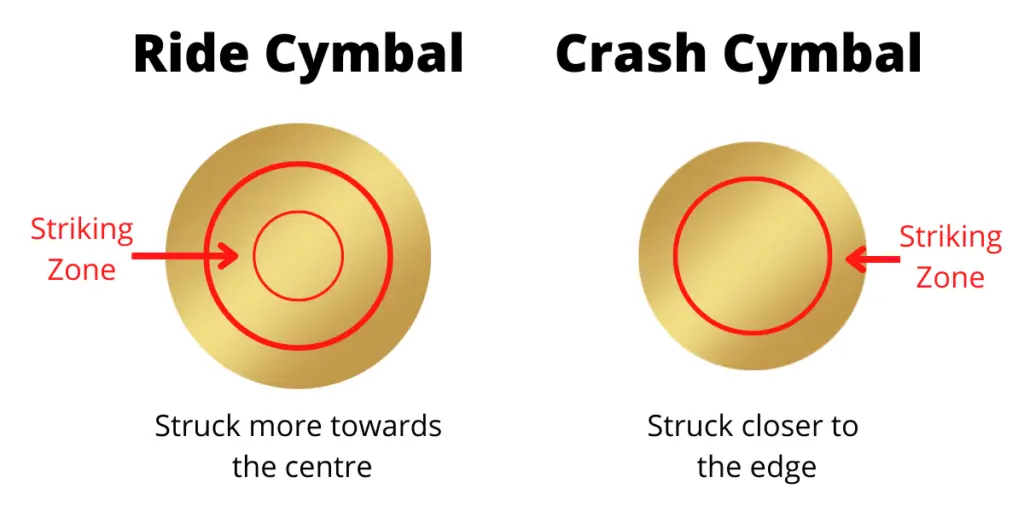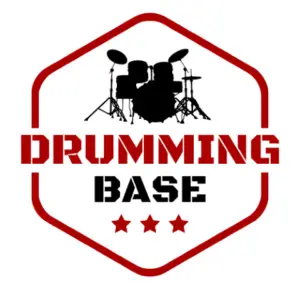Many drummers like to have a leaner kit to help cut costs and make transportation easier. One way to do this is to use fewer cymbals. The ride cymbal is generally used more frequently than the crash cymbal, so is it possible to ditch the crash cymbal and crash your ride cymbal instead when you need to?
It is possible to crash a ride cymbal by striking it with the shoulder of the drumstick towards the edge of the cymbal, as opposed to striking it towards the centre with the tip. This will produce a louder sound with more shimmer and sustain, but will not sound as bright as a crash cymbal.
Crash vs Ride Cymbals
Let’s discuss some of the fundamental differences between crash and ride cymbals.
- Ride cymbals are thicker and heavier compared to crash cymbals
- Ride cymbals have a larger diameter (18-22″) compared to crash cymbals (14-18″)
Crash cymbals sound brighter due to their smaller diameter, whereas ride cymbals sound more mellow and produce a sound with a lower pitch. Also, since crash cymbals are thinner, they have a faster “attack” and also sound more shimmery compared to ride cymbals which sound short and sharp.
Check out this article comparing crash and ride cymbals to learn more.
As well as the sound and structural differences between these two types of cymbal, they also are usually struck in different places.
- Crash cymbals are struck close to the edge using the shoulder of the drumstick to produce a shimmery tone with more sustain and wash
- Ride cymbals are struck in the centre using the tip of the drumstick to produce a shorter, sharper sound with less sustain
Since a lot of the sound differences between ride and crash cymbals are related to the way they are struck, and not just the structural differences between them, it is possible to crash a ride cymbal by striking it on the edge with the shoulder of the drumstick.

Crashing a Ride Cymbal (The Effects)
When you hit a ride cymbal on the edge using the shoulder of the drumstick to try and crash it, you’ll notice three sound differences compared to striking it normally:
- It will sound louder
- It will have more shimmer
- It will have more sustain
Here’s a great video on YouTube where you can hear the difference between the ride cymbal being hit normally (using the tip in the centre) and being used as a crash (using the shoulder on the edge).
In the video you can also here the difference between the ride and crash cymbals when they are both hit on the edge to try and crash them. You’ll notice that:
- The crash cymbal sounds brighter as it has a higher pitch compared to the ride cymbal
- The crash cymbal has more attack and sounds more direct compared to the ride cymbal
In essence, when you try and crash a ride cymbal it will sound more mellow, heavier and slower compared to crashing a designated crash cymbal. Some people really like this type of sound, others don’t; it’s really a personal preference.
Crashing a ride cymbal should not cause any damage as long as the cymbal is structurally sound and is struck correctly. In fact, a ride cymbal is less likely to get damaged when crashed compared to a designated crash cymbal as it is thicker so can withstand more force.
Which Ride Cymbals are Best for Crashing?
Thinner ride cymbals work best for crashing compared to thicker ride cymbals. This is because thinner cymbals have a faster attack so sound more direct as they do not weigh as much. Hence, a thinner ride cymbal will sound closer to a crash cymbal, compared to a thicker and heavier one.
It’s also best to use a ride cymbal with a smaller diameter for crashing. Most ride cymbals have a diameter of 18-22″. The larger the diameter, the lower the pitch of the cymbal will be and the more mellow it will sound. To get the high-pitched crashing sound, it’s best to use a ride cymbal which has a diameter of 20″ or less.
Consider a Crash/ Ride Cymbal
If you want a cymbal that can do both, consider getting a crash/ ride cymbal. There typically have a diameter of 16-20″ and a medium thickness so can be used to crash, or to ride, depending on how they are struck.
The pitch of a crash/ ride cymbal will be higher than a traditional ride cymbal, and lower than a traditional crash cymbal. In terms of attack, a crash/ride is faster than a ride cymbal, but slower than a crash cymbal. Essentially, they’re a halfway house between the two cymbal types.
You can also get ride/ crash cymbals which again have that dual function but are usually thicker and heavier so favour the ride function.
Check out this article on riding the crash cymbal for the answer to the opposite question!
Take a look at this article on crashing the hi-hat cymbal for more ways to experiment.

